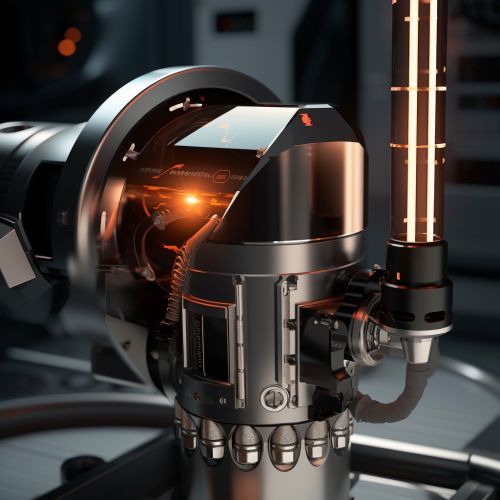Field Emission Electric Propulsion
Overview
Field Emission Electric Propulsion (FEEP) is a type of electric propulsion system that utilizes a liquid metal, typically indium or caesium, as a propellant. The system operates on the principle of field electron emission, where a strong electric field is applied to a liquid metal, causing it to emit ions. These ions are then accelerated to high velocities, producing thrust.
Principles of Operation
The operation of a FEEP system is based on the phenomenon of field emission, also known as Fowler-Nordheim tunneling. This is a quantum mechanical process where electrons can tunnel through a potential barrier in the presence of a strong electric field. In a FEEP thruster, the liquid metal propellant is held in a reservoir and fed through a narrow capillary tube to a sharp emitter tip. A strong electric field is applied between the emitter and an extractor electrode, causing the liquid metal to form a thin, stable film at the tip of the emitter. The electric field is sufficiently strong to cause the metal atoms in the film to ionize and be ejected as a jet of ions, producing thrust.
Propellant
The choice of propellant in a FEEP system is critical to its performance. The propellant must be a liquid at the operating temperature of the thruster, and it must have a high atomic mass and a low ionization potential. Indium and caesium are commonly used because they satisfy these requirements. Indium has the advantage of being non-toxic and relatively easy to handle, while caesium provides higher performance due to its lower ionization potential.
Performance
The performance of a FEEP system is characterized by its specific impulse and thrust. Specific impulse is a measure of the efficiency of a propulsion system, defined as the thrust per unit mass flow rate of propellant. FEEP systems can achieve very high specific impulses, on the order of 5000 to 10000 seconds, which is significantly higher than most other types of electric propulsion. The thrust produced by a FEEP system is typically very low, on the order of micro-newtons to milli-newtons. However, the thrust can be precisely controlled and modulated, making FEEP systems ideal for fine attitude control and station keeping applications.
Applications
FEEP systems are primarily used for fine attitude control and station keeping of spacecraft. They are particularly well-suited for these applications due to their high specific impulse, precise thrust control, and low power consumption. FEEP systems have been used on a number of space missions, including the SMART-1 lunar orbiter and the LISA Pathfinder mission to test technologies for detecting gravitational waves.
Advantages and Disadvantages
FEEP systems offer several advantages over other types of electric propulsion. They have a very high specific impulse, which means they can provide a large amount of thrust for a given amount of propellant. This makes them very efficient and allows for long mission durations. They also offer precise thrust control, which is important for fine attitude control and station keeping. However, FEEP systems also have some disadvantages. They require a high voltage power supply, which can be complex and bulky. They also produce a very low thrust, which limits their applicability to certain types of missions.
Future Developments
Research is ongoing to improve the performance and reliability of FEEP systems. One area of focus is the development of new propellants that offer better performance and are easier to handle than indium or caesium. Another area of research is the design of the emitter and extractor electrodes, with the goal of increasing the ion emission current and thus the thrust. There is also interest in developing FEEP systems that can operate at lower voltages, to reduce the complexity and size of the power supply.
See Also


